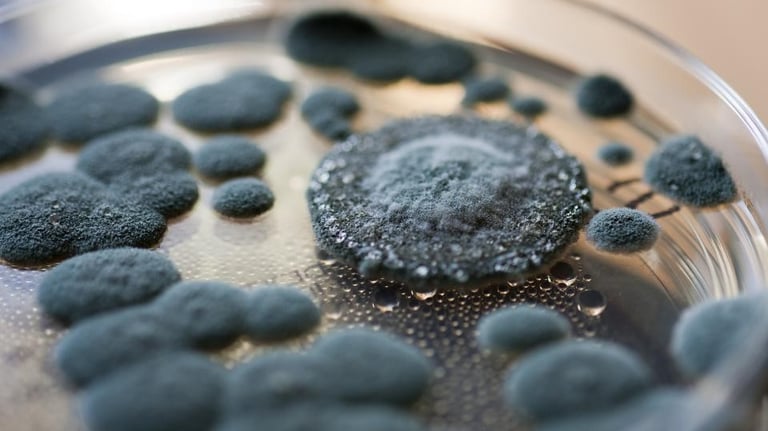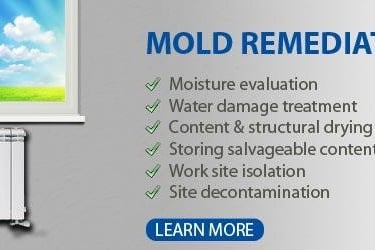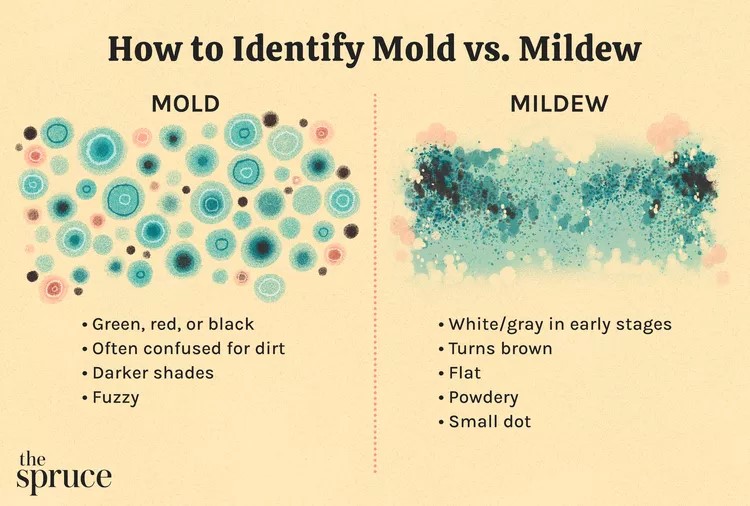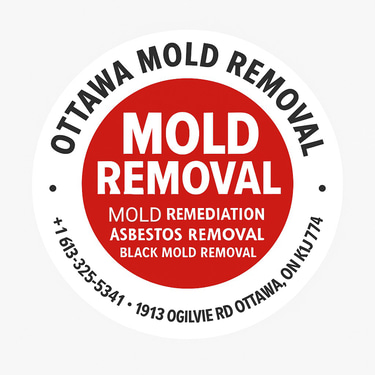Mold Removal Services in Ottawa
Mold is a dangerous, invasive substance that can negatively affect your health and your home or business. Having mold in your home can lead to frustrating problems, including serious health issues, poor air quality, and even expensive damage to ceilings, walls, floors, and other structures in your home.




For mold testing and removal services in Ottawa and the surrounding cities and municipalities, look no further than the comprehensive services offered at Aucoins. We use an intensive mold remediation process to identify all the affected areas, and the type of mold involved, and determine the best way to eradicate it. It is important to have a professional determine the level of mold infestation, as mold exposure can affect you, your home, and anyone in recent contact with you.
What Causes Mold?
Mold is a naturally occurring process that helps to break down organic matter outdoors such as leaves, dead wood, and organisms. However, when it happens indoors, it can potentially be harmful, impact air quality, and cause unsightly stains or spots on walls, floors, and interior or exterior walls.
There are over 100,000 species found on the planet, and around 1,000 of those mold species are commonly found in Canada. Since mold requires moisture to grow and thrive and is usually caused by excessive moisture or water exposure, it can be prevalent during the wet winters of Ottawa.
Common causes of mold include:
Water leaks
Flooding
High humidity
Condensation
Poor air quality or ventilation
Wet or damp clothing piling up
In residential environments, several things can cause or contribute to the growth of mold. Everyday actions such as showering or cooking can increase the development of mold over time, so it is important to be mindful, increase air quality, and have access to high quality mold remediation services near you to help remove any stubborn mold that may be present in your home.
It is important to note that mold and mould are the same thing and present the different kinds of spelling used for the word. Depending on what resources you are looking at, you may see mold vs mould being used, but they have the same meaning and both refer to the fungus that can grow within your home.
Do I Need Professional Mold Cleaning Services
If you notice mold is present in your home, your first step is to look into proper mold removal options.
In minor cases, homeowners may be able to remove the mold when on their own with products such as mold spray. However, large patches of mold, specifically, any area that measures larger than three square meters, should be handled by a professional.
You should look into professional assistance for:
Attic mold removal
Basement mold removal
Baseboard mold removal
Concrete mold removal
Foundation mold removal
Black mold removal
Insulation mold
Calling in a professional for mold cleanup in your home can help ensure that you get help with potentially complex issues, such as mold testing and inspection after flooding.
If you suspect there is an issue in your home, a mold inspection can be done in Ottawa by experts with real-world experience who service the surrounding areas, such as Kemptville, Carleton Place, Orleans, Kanata, Cornwall, Cumberland, Casselman, Brockville, Rockland, Dunrobin, Morrisburg, Alfred, Sharbot Lake, and Barrhaven.
What is Black Mold?
Source:
PSA Canada
Mold spores can produce substances called mycotoxins that are poisonous and can cause harm to animals and humans when they come into contact with it through skin, breathing, or consumption of mold. Mold comes in many colors, and one of the most infamous and toxic types of mold is known as black mold. Stachybotrys chartarum is the scientific term for a commonly found type of mold, and though it is often known as black mold, it can be found in various colors, such as green, brown, or gray. Removal of black mold can safely be done by a professional, as it releases mycotoxins and exposure to this mold can be very toxic. It’s also worth noting that other kinds of mold may be black and not S. chartarum.
Types of Molds
Mold v. Mildew
In addition to the most commonly known black mold, various other colors and types of mold can grow in your home. Mildew is also a type of mold, and often is used interchangeably, but generally can be easier to contain and treat than other kinds of mold fungus.



Source:
The Spruce / Joules Garcia
Oftentimes, when referring to the damp smell or presence of moisture in walls, surfaces, floors, and furniture, it is referred to as mildew. Mildew and mold are often found in areas where moisture is often present. However, while they can sometimes be used interchangeably, it is important to note that mold and mildew may present differently and some mold may be more toxic or difficult to eliminate than mildew.
Common Types of Household Mold
Mold can be categorized into three main types determined by the effects they can have on your health.
Pathogenic molds can cause infection in humans and may lead to illness.
Allergenic molds can cause allergy symptoms that can make humans very uncomfortable in larger quantities.
Toxic molds may sometimes be confused with pathogenic, but are notably more dangerous to humans and can lead to significant health complications.
The best way to determine what kind of mold you have is to call in a professional. Otherwise, identifying mold in your home can be done by comparing colors, identifying factors, and other features to determine what type of mold and how serious it may be.
Alternaria
Is dark green to brown in appearance and can have a hairy or velvety texture
Often found in damp areas such as bathrooms and in homes that have water damage
Allergenic mold
This mold is naturally found outdoors on vegetation and plants but can become airborne and find its way to moisture-heavy areas within your home.
Aspergillus
Is usually greenish or black, but can appear in many colors as small dots or as “flecks”
Found in wooden surfaces like walls
Allergenic and Toxic mold
This is one of the most common indoor molds and grows alarmingly fast and has a tendency to infest air circulation systems and attack any open foods, fruits, or vegetation in your home.
Aureobasidium
Can first appear cream or pink, but may turn brown or black as it ages. Tends to have a slimy texture
Found in damp environments, like bathrooms or on wooden surfaces and walls or behind wallpaper and painted surfaces
Allergenic mold
This is a common, stubborn household mold, as it tends to be sneaky and hard to find in your home.
Chaetomium
Around white, gray, or brown in appearance with a fluffy cotton texture
Usually appears in places where significant water damage has occurred
Allergenic and Toxic mold
Chaetomium appears in areas where water damage has recently occurred, and can often be recognized by the strong, stale smell of mildew.
Cladosporium
Can appear green to brown and is suede-like in texture
May be found within your furniture, or other indoor fabrics such as drapes and carpets
Type of Mold: Allergenic
This mold thrives in hot and cold seasons, making it especially prevalent in Canadian homes.
Fusarium
White, pink, or red in appearance, with a velvet to cotton-like texture
Thrives on food, and compost and may be found within carpers, furniture, or wallpaper
Allergenic and Toxic mold
Fusarium is also quick to spread within your home. Oftentimes, if found in one room, you are likely to find this mold in another part of your home.
Penicillium
Blue to green in color with a velvety texture
Generally develops where water damage or heavy moisture has been significant
Allergenic mold
This mold may have a common-sounding name, but exposure to Penicillium can have adverse side effects on your health if left untreated within your home.
Stachybotrys (“Black Mold”)
Dark green or black, texture can vary based on its state but usually is shiny or slimy
Often found in high moisture areas like bathrooms and basements
Toxic mold
This mold has already been mentioned, but as one of the most toxic and common molds found in households, it is extremely important to take care of it properly and with the right professional help.
Trichoderma
Can be anywhere from white to green in color and have wooly patches
Appears on damp surfaces and forms commonly on wallpaper, carpets, and interior fabrics
Allergenic mold, though some strains can be toxic
This type of mold can cause significant damage to a residence made of wood, as it can quickly cause wood products to rot and fall apart.
Ulocladium
Brown to black with a fluffy wooly texture
Found in areas with high condensation, such as bathrooms, basements, kitchens, and on windows and mirrors
Allergenic mold
This type of mold usually doesn’t travel alone, which means if you see this type of mold, there may be several other kinds within the home. It is sometimes mistaken for black mold.
Professional Mold Removal in Ottawa and the Surrounding Areas
Once mold has been discovered in the home, the next steps should be to take measures to get rid of it. If you suspect mold but aren’t quite sure whether it is mold or something else, or if you will need professional remediation, you can look into what type of mold testing is right for you to help you make the next steps. Mold removal and remediation services can help restore your home to a safe, healthy, clean-air environment.
Source:
The Spruce / Joules Garcia
Oftentimes, when referring to the damp smell or presence of moisture in walls, surfaces, floors, and furniture, it is referred to as mildew. Mildew and mold are often found in areas where moisture is often present. However, while they can sometimes be used interchangeably, it is important to note that mold and mildew may present differently and some mold may be more toxic or difficult to eliminate than mildew.
Common Types of Household Mold
Mold can be categorized into three main types determined by the effects they can have on your health.
Pathogenic molds can cause infection in humans and may lead to illness.
Allergenic molds can cause allergy symptoms that can make humans very uncomfortable in larger quantities.
Toxic molds may sometimes be confused with pathogenic, but are notably more dangerous to humans and can lead to significant health complications.
The best way to determine what kind of mold you have is to call in a professional. Otherwise, identifying mold in your home can be done by comparing colors, identifying factors, and other features to determine what type of mold and how serious it may be.
Alternaria
Is dark green to brown in appearance and can have a hairy or velvety texture
Often found in damp areas such as bathrooms and in homes that have water damage
Allergenic mold
This mold is naturally found outdoors on vegetation and plants but can become airborne and find its way to moisture-heavy areas within your home.
Aspergillus
Is usually greenish or black, but can appear in many colors as small dots or as “flecks”
Found in wooden surfaces like walls
Allergenic and Toxic mold
This is one of the most common indoor molds and grows alarmingly fast and has a tendency to infest air circulation systems and attack any open foods, fruits, or vegetation in your home.
Aureobasidium
Can first appear cream or pink, but may turn brown or black as it ages. Tends to have a slimy texture
Found in damp environments, like bathrooms or on wooden surfaces and walls or behind wallpaper and painted surfaces
Allergenic mold
This is a common, stubborn household mold, as it tends to be sneaky and hard to find in your home.
Chaetomium
Around white, gray, or brown in appearance with a fluffy cotton texture
Usually appears in places where significant water damage has occurred
Allergenic and Toxic mold
Chaetomium appears in areas where water damage has recently occurred, and can often be recognized by the strong, stale smell of mildew.
Cladosporium
Can appear green to brown and is suede-like in texture
May be found within your furniture, or other indoor fabrics such as drapes and carpets
Type of Mold: Allergenic
This mold thrives in hot and cold seasons, making it especially prevalent in Canadian homes.
Fusarium
White, pink, or red in appearance, with a velvet to cotton-like texture
Thrives on food, and compost and may be found within carpers, furniture, or wallpaper
Allergenic and Toxic mold
Fusarium is also quick to spread within your home. Oftentimes, if found in one room, you are likely to find this mold in another part of your home.
Penicillium
Blue to green in color with a velvety texture
Generally develops where water damage or heavy moisture has been significant
Allergenic mold
This mold may have a common-sounding name, but exposure to Penicillium can have adverse side effects on your health if left untreated within your home.
Stachybotrys (“Black Mold”)
Dark green or black, texture can vary based on its state but usually is shiny or slimy
Often found in high moisture areas like bathrooms and basements
Toxic mold
This mold has already been mentioned, but as one of the most toxic and common molds found in households, it is extremely important to take care of it properly and with the right professional help.
Trichoderma
Can be anywhere from white to green in color and have wooly patches
Appears on damp surfaces and forms commonly on wallpaper, carpets, and interior fabrics
Allergenic mold, though some strains can be toxic
This type of mold can cause significant damage to a residence made of wood, as it can quickly cause wood products to rot and fall apart.
Ulocladium
Brown to black with a fluffy wooly texture
Found in areas with high condensation, such as bathrooms, basements, kitchens, and on windows and mirrors
Allergenic mold
This type of mold usually doesn’t travel alone, which means if you see this type of mold, there may be several other kinds within the home. It is sometimes mistaken for black mold.
Professional Mold Removal in Ottawa and the Surrounding Areas
Once mold has been discovered in the home, the next steps should be to take measures to get rid of it. If you suspect mold but aren’t quite sure whether it is mold or something else, or if you will need professional remediation, you can look into what type of mold testing is right for you to help you make the next steps. Mold removal and remediation services can help restore your home to a safe, healthy, clean-air environment.Professional mold remediation is a much more extensive process that requires high-level skills and tools to clean, disinfect, remove, and eliminate it from coming back. Remediation services will identify and remove any contaminated material and mold that was found to ensure that it doesn’t find its way into other areas of the home after removal.
Protect Your Home with Mold Cleanup Services
When you have a small amount of mold or mildew on surfaces, or walls, mold removal with spray and mold removal products can help to address the problem. Removing mold on a small scale can be done properly by homeowners, but it is extremely important to use protective equipment to reduce exposure to any potentially toxic mold or spreading mold spores via skin or clothes.
If you come across large or multiple contaminated areas, such as mold in the attic, mold on baseboards, or insulation mold within the walls, you may need to call in a professional to help address the mold and provide removal services that eliminate it at the source and prevent mold regrowth from occurring. You may also need professional help to remove black mold in your home.
When left untreated, mold can spread throughout the surfaces and interior of your home, causing structural damage and posing serious health risks. Mold releases spores as it spreads, which can be present in the air, on your clothes, and throughout your home. Exposure to mold can lead to uncomfortable symptoms such as:
Irritation of the eyes, nose, throat, and lungs
Excessive coughing
Wheezing and shortness of breath
Mucus and phlegm build-up
Allergic reactions
Worsening asthma symptoms
Other symptoms like fatigue, headaches, eye irritation, fever, or other issues can also be signs of mold toxicity. If you are suddenly experiencing health symptoms that may increase when exposed to certain areas of your home or have started randomly without another explanation, you might consider a mold inspection on your Ontario home.
Residential Mold Removal in Ottawa
If you find mold in your residence, it may be time to call in the professionals. Regardless of the type of mold, it can often be difficult to completely eradicate and instill strong ways to prevent mold from coming back.
If you live in Ottawa, Kemptville, Carleton Place, Orleans, Kanata, Cornwall, Cumberland, Casselman, Brockville, Rockland, Dunrobin, Morrisburg, Alfred, Sharbot Lake, or Barrhaven, you can turn to the mold testing services at experts at Simon Air Quality. With a focus on identifying the mold and providing high-quality mold removal and remediation services, our team can help eradicate mold issues and provide tips and solutions to help prevent it from developing further in your home.
To learn more about mold testing and removal services near you or to ask about improving the overall air quality in your home, contact us today or use the messenger service at the bottom of the page.
Click Here to Call us at: 613-325-5341

Mold growth in homes is a serious concern that many Ottawa residents may overlook until it becomes a health issue. Mold is not only unsightly but can also have significant effects on the respiratory system. Understanding the connection between mold and respiratory health is crucial for homeowners in Ottawa, where humidity levels and aging homes create ideal conditions for mold growth. In this article, we will explore how mold affects respiratory health and what steps Ottawa homeowners can take to prevent and address mold growth through mold removal in Ottawa.
What is Mold and How Does it Grow in Homes?
Mold is a type of fungus that thrives in damp, humid environments. It reproduces through spores that spread through the air and can settle on surfaces, where they grow when exposed to moisture. Common indoor molds include species such as Aspergillus, Cladosporium, and Stachybotrys (black mold).
Mold requires moisture to grow, which is why it is frequently found in areas of the home where water damage or high humidity is present, such as basements, bathrooms, and attics. In Ottawa, the seasonal fluctuations in temperature and humidity contribute to mold growth, particularly in older homes that may have structural issues like leaks or poor insulation. It’s important for homeowners to recognize the conditions that promote mold and take steps to mitigate the risks.
The Respiratory Health Risks of Mold Exposure
Mold exposure is linked to several respiratory health problems. The most common issues include allergic reactions, asthma, chronic coughing, and sinus congestion. Mold spores, when inhaled, can trigger these conditions, especially in sensitive individuals. People with asthma or respiratory diseases are at a higher risk of experiencing exacerbated symptoms, which can lead to more severe health issues over time.
For Ottawa residents, the humid summers and cold winters can create the perfect breeding ground for mold, especially in homes that have had water damage due to flooding or condensation. Even if the mold is not visibly present, its spores can still be in the air, causing respiratory distress in those who are exposed to it regularly.
Mold Growth in Ottawa Homes: Specific Concerns
Ottawa’s climate presents unique challenges for homeowners trying to avoid mold growth. During the humid summer months, moisture can accumulate in the home, and without proper ventilation, mold can start to grow. In winter, the cold air outside can lead to condensation on walls and windows, creating the perfect environment for mold to thrive.
Older homes in Ottawa are particularly susceptible to mold growth due to outdated insulation, poor ventilation, and the likelihood of hidden leaks in the plumbing. Homeowners who experience basement flooding, roof leaks, or faulty windows should be especially diligent about monitoring for mold growth and taking preventive measures.
Identifying Mold-Related Health Symptoms
If you suspect that mold might be affecting your home, it’s essential to watch for signs of respiratory issues, especially in family members who may be particularly sensitive. Common symptoms of mold exposure include:
Persistent coughing or wheezing
Nasal congestion or a runny nose
Sneezing, especially in the morning
Irritation of the throat, eyes, or skin
Fatigue and general malaise
Press enter or click to view image in full size
For Ottawa homeowners, recognizing these symptoms early can prevent further complications. If anyone in your household is experiencing these issues and you suspect mold may be the culprit, seeking mold removal in Ottawa should be a priority. Early intervention can help mitigate health risks and protect the home’s occupants from ongoing exposure.
Mold Prevention and Remediation in Ottawa Homes
Preventing mold growth in Ottawa homes is possible with proper maintenance and attention to moisture control. Key steps to prevent mold include:
Control Humidity Levels: Keep indoor humidity levels below 60%. This can be achieved using dehumidifiers, especially in areas like basements or bathrooms.
Improve Ventilation: Proper ventilation is essential in areas prone to moisture, such as bathrooms and kitchens. Ensure that vents lead outdoors, not into attics or crawl spaces.
Fix Leaks Quickly: Water leaks are the most common way mold enters a home. Whether it’s a leaking pipe, a roof leak, or condensation around windows, repairing leaks as soon as they occur can help prevent mold from taking hold
Routine Inspections: Regularly check areas where mold is more likely to grow, such as the basement, attic, and behind appliances. If you spot early signs of mold growth, act immediately by calling in a professional for mold removal in Ottawa.
If mold has already taken hold in your home, it’s important to enlist the help of professional mold remediation services. Mold removal in Ottawa involves specialized equipment and techniques to ensure that the mold is fully removed, and the underlying moisture problems are addressed. Trying to remove mold yourself can sometimes make the issue worse, as mold spores can spread if not properly contained.
Protect Your Health: The Importance of Mold Removal in Ottawa Homes
If you suspect mold is affecting your home, taking action is crucial not only for the well-being of your property but also for the health of your family. Mold removal in Ottawa is essential for eliminating mold-related health risks and improving indoor air quality. Professional remediation services can safely remove the mold, identify the source of moisture, and provide recommendations for keeping your home mold-free.
Take Action Today
Don’t wait until mold affects your health. If you suspect mold in your home, contact a professional mold removal company in Ottawa right away. By addressing mold issues early, you can prevent respiratory health problems and ensure that your home remains a safe, healthy place for you and your family.
Press enter or click to view image in full size
If you live in Ottawa and are concerned about mold in your home, make sure to schedule an inspection with a trusted mold removal in Ottawa expert. Protect your home and your health by taking the necessary steps today.
ottawa mould
Contact
Support
mould
© 2024. All rights reserved.
